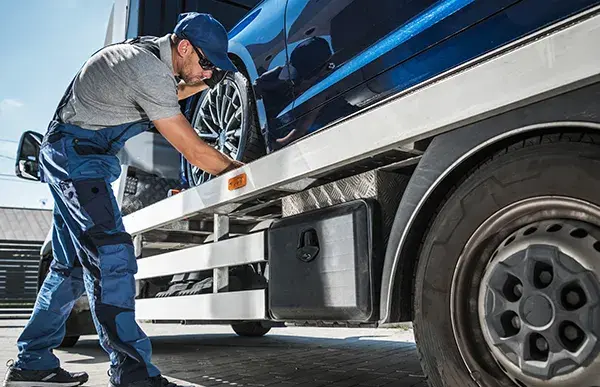How to Ship a Car
Moving to a new city can be a tedious, time-consuming, and downright daunting process – and shipping your car is one of the most challenging parts of moving. Instead of trying to drive your car to your new location, finding a shipping company to do it for you is often a much better option as it saves tons of time and unnecessary wear-and-tear on your vehicle.
Thankfully, hiring an auto transportation company to ship your car is an easy process, and takes very little time. Our streamlined process ensures a hassle-free experience from start to finish, and takes just three easy steps. Below, we provide a step-by-step breakdown of how car shipping works, what to expect, and how to prepare for your vehicle's transportation journey.


Step 1: Get a quote and book your order
To get started, you’ll first need to request a quote. When requesting a quote, we just ask that you provide a few key details including your vehicle’s make and model, the pickup and drop-off locations, and your preferred transport type (either open or enclosed carrier) for us to provide you with an accurate estimate.
Once you receive our quote, review the details and decide whether you’d like to go forward with us. While you don’t have to confirm an order with us immediately after receiving a quote, you will have to do so within seven days. Otherwise, you’ll need to request a new quote from us – this is because auto shipping market prices fluctuate daily. If you choose to move forward, you’ll confirm your booking by providing necessary contact details, vehicle specifications, and any other necessary info. At this stage, you’ll also be given an estimated pickup window based on current carrier availability and your preferred schedule.

Step 2: Your Vehicle Gets Picked up
On your scheduled pickup date, a licensed and insured carrier will arrive at the agreed pickup location – this will either be at a terminal pickup point, or your home if you decide to go with our Door-to-Door shipping option.
Before loading the vehicle, the carrier will conduct a comprehensive pre-transport inspection and fill out the BoL (Bill of Lading). This includes documenting the current condition of your vehicle through photographs and a written report, which ensures transparency and protection for your vehicle.
Once the inspection is complete, your car will be securely loaded onto the transport carrier. The carrier will use specialized equipment, like soft straps and wheel chocks, to prevent any movement during transit. If you have opted for an enclosed carrier, your vehicle will be loaded inside of an enclosed trailer which offers additional protection from weather and road debris.
Throughout the transportation process, you can track your vehicle’s progress in real time using our tracking system or by contacting our customer support team directly for updates.

Step 3: Your Vehicle Gets Dropped off
Upon arrival at the designated drop-off location, you’ll meet the carrier, who will carefully unload your vehicle. Or if you are unavailable to pick up your vehicle, you can have a family member or friend to pick it up on your behalf instead.
At this point, another thorough inspection will be conducted where they’ll compare the condition of your vehicle before and after transport. This is done to make sure your vehicle wasn’t damaged at all during the shipping process.
After you and the carrier confirm that your vehicle’s in the same condition prior to shipment, you’ll complete the final paperwork, pay any remaining fees, and take your vehicle – and that’s it!
Frequently Asked Questions
How long are quotes valid?
Quotes are generally valid for 7 to 14 days. However, due to fluctuations in market demand, fuel costs, and carrier availability, prices may change after this period. To secure the best rate, we recommend booking your order as soon as possible.
Can I receive a quote without knowing the exact drop-off address?
Yes, we can provide an estimate based on a general location such as a city or zip code. However, for the most precise pricing, it’s best to provide the exact pickup and drop-off addresses. This ensures accurate calculations of distance, accessibility, and any potential additional costs for remote or hard-to-reach areas.
What should I do to prepare for my car’s shipment?
Prior to transport, there’s a pretty lengthy list of things that you should do beforehand to have the most seamless transport possible. Here’s the list of everything to be done:
- Disable all alarm systems that may be active in the car.
- Remove any loose parts, fragile accessories, and personal items inside or out of your vehicle. This is to avoid anything breaking or being stolen during the transportation process.
- Wash your car. This is done so the carrier can properly fill out a condition report for the car upon pickup. It’s also so that you can take a personal note of the current condition of your vehicle, and give you proof of its condition beforehand if it is damaged during transportation.
- Have a pair of your car’s keys ready to give to the carrier.
Will my vehicle be insured during transportation?
Absolutely. Your vehicle will be fully insured throughout its journey. Our carriers provide coverage for damages incurred during transit, ensuring peace of mind. Before shipping, you’ll receive details on the specific coverage amounts.
How long will the shipping process take?
The length of time it takes to ship one’s vehicle entirely depends on several different factors. These include the pickup and dropoff locations, the total travel distance (the further distance, the longer it will take), and time of the year.
In addition, those who live in more rural areas further from main highways and dropoff terminals will take longer to transport as well, as carriers will have to go more out of their way to transport your car.
Poor weather conditions, such as snow or rain storms, will further slowdown carriers, so expect deliveries to take a few more days than typical in such conditions.
How much does it cost to ship my car?
The price of shipping a car will vary greatly depending on these factors:
- The distance between the pickup and drop-off points: This is fairly obvious, but the further distance driven, the more expensive it will be. Longer distances require more fuel, man hours, and sleep accommodations for the carrier, which all factors into the overall shipping cost.
- The time of year: The time of year can have a great effect on shipping costs. This is because there are peak seasons of the year where more people are looking to ship their cars, which impacts the cost of shipments. This is typically during the holiday season and Summertime, which are popular moving seasons.
- Area of shipment: The region that you are shipping to or from may also impact the overall price of shipping. Shipping to or from states with more expensive fueling costs, such as New York, California, Oregon, and Washington, will result in more expensive shipping versus states where fueling costs are overall more affordable.
- Special vehicle shipping: If you possess an antique, luxury, or exotic vehicle, it may cost more to ship. Not all vehicles are fit for standard shipping, and not all carriers can ship all types of cars. For this reason, it’s important to do a bit of research on your car before finding a carrier.

